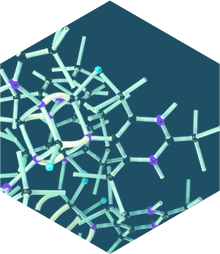
Cerebrocholin for Promotion of Successful Cognitive Aging
Cerebrocholin is a brand of citicoline inner salt manufactured by Kaiping Genuine (Kaiping, PRC) and distributed in Europe by Edge Pharma sp. z o.o. (Warsaw, Poland).
Cerebrocholin is a cluster of two words: Cerebro- and -cholin.
The first, Cerebro-, relates to the fact that brain is the target organ for citicoline pharmacodynamic action. Prior to being formally pronounced a „novel food” in EU, citicoline was available only as a prescription drug proven to display nootropic (pro-cognitive) effects.
The second word, -cholin, relates to the fact that citicoline innert salt is considered a source of choline, a vitamin-like substance essental for the maintenance of human memory and cognition.
According to the Implementing Decision of the European Commission Citicoline is intended to be used in food supplements aimed at a target population of middle-aged to elderly adults. There is a good reason for such indication. Demand for choline is only partially fulfilled by synthesis in the human body, while the rest must be sourced from food. Aging is a natural, inevitable phenomenon, therefore it shall not be considered a disease.
When people age, their bodies’ ability to make choline decreases along with failing memory, a phenomenon called Age-Associated Memory Impairment (AAMI). In two large population studies comprising together more than 3 thousand elderly people who did not suffer from any neurological disease, choline deficiency has been found to correlate with memory dysfunction.
If AAMI occurs along with insufficient choline delivery during aging, shouldn’t middle-aged and older people rather take choline supplements? Well, the problem is that free choline in large doses is toxic, whereas citicoline in doses providing the equivalent choline intake is much, much less toxic. Moreover, upon oral intake choline as well, as many other choline compounds encountered in food (eg. lecithin) are to a significant degree metabolized by intestine bacteria to potentially toxic substances (TMA, TMAO). It was suggested that citicoline is not toxic because it is resistant to such degradation.
Alltogether, Cerebrocholin (citicoline inner salt) is a safe and efficacious compound, which intake reinforces choline availability to the brain cholinergic system involved in human memory and cognition.
General information
Cerebrocholin manufactured by Kaiping Genuine Biochemical Pharmaceutical Co. Ltd. is fully equivalent to the novel food authorized for the first time to be placed on the European Union market by the Commission Implementing Decision of 1 July 2014 authorizing the placing on the market of citicoline as a novel food ingredient under Regulation (EC) No 258/97 of the European Parliament and of the Council.
Cerebrocholin is manufactured biotechnologically with a fermentative process that involves brewer’s yeast (Sacharomyces cerevisiae). In this process cytidine monophosphate (CMP) and choline chloride are used as raw materials. Yeast residue is removed by flocculation filter-press to obtain crude clear solution. Further purification involves chromatography through an anion exchange resin, crystallization and drying.
Quality of each delivery of Cerebrocholin and its conformance to the specification set by the aforementioned EU Implementing Decision is tested by an independent EU-certified laboratory.
Citicoline – legal status in EU1
Citicoline (more specifically citicoline inner salt) is a food ingredient designed to supplement natural intake of choline and cytidine in the body. It is a highly purified substance which upon intake is readily hydrolysed, breaking down to choline and cytidine which are normal body constituents, and which then undergo further metabolism and incorporation into normal pathways of metabolism.
Citicoline is intended to be used in food supplements aimed at a target population of middle-aged to elderly adults, at a maximum level of 500 mg/day, and in foods for particular nutritional uses, specifically foods for special medical purposes, at a maximum level of 250 mg/serving, and with a maximum daily intake from these types of foods of 1 000 mg/day.
Citicoline is not intended to be consumed by children.
Cerebrocholin is suitable for the following types of products:
01.
+ FOOD SUPPLEMENTS
A dictionary definition states that a Food Supplement is a preparation that is intended to supply a nutrient that is missing from a diet.2 (This statement involves a tacit assumption that a balanced diet containing all necessary and sufficient nutrients in adequate amounts can be defined, but this is not always the case.)
02.
+ FOODS FOR SPECIAL MEDICAL PURPOSES
European Food Safety Agency (EFSA)3 defines Food Supplements as concentrated sources of nutrients or other substances that are marketed in “dose” form (e.g. pills, tablets, etc.). They are not medicinal products, as such cannot exert a pharmacological, immunological or metabolic action, and their use is not intended to treat or prevent diseases in humans or to modify physiological functions. (But isn’t it that nutrition, by providing the body with the optimal balance of nutrients needed for good health, is primarily aimed to prevent diseases? 4)
03.
+ FUNCTIONAL FOODS
A Functional Food is a food given an additional function (often related to health-promotion or disease prevention) by adding new ingredients (or more of existing ingredients.)
A food can be regarded as ‘functional’ if it is satisfactorily demonstrated to affect beneficially one or more target functions in the body, beyond adequate nutritional effects, in a way that is relevant to either an improved state of health and well-being and/or reduction of risk of disease.5
Choline in the human body
Choline is a precursor of many molecules of high biological importance
For humans choline is an essential nutrient7
But a substantial fraction of choline is metabolized by intestinal bacteria
Citicoline is the unique dietary source of choline
The uniqueness of citicoline among choline derivatives seems to be related to that its choline moiety is bound to cytidine through the pyrophosphate group. This unusual chemical structure may have important consequence. Persuasive experimental data indicate that citicoline is not metabolised to TMA by intestinal microbiome.

First, no sign of cholinergic intoxication (which certainly would be expected upon hydrolysis of citicoline and liberation of free choline in the intestine) was evident following ingestion of very high citicoline doses. The authors12 concluded that choline shows a remarkable cholinergic action, while the same molar doses of citicoline, given either orally or intravenously, do not cause any cholinergic intoxication in the treated groups.

Second, following ingestion of citicoline labelled with carbon-14, less than 1% of the dose was found in the feces, indicating almost total absorption. Elimination of the label occurred primarily via expired CO2 and urine, indicating that citicoline metabolites entered their respective natural metabolic pools, moreover only 16% of the dose was excreted within 5 days.13 Complete absorption of carbon-14 labelled citicoline following oral intake has also been shown in the other study.14
The aforementioned data show that citicoline may be the safest food supplement providing choline required for many biological functions of the human body.

Once a prescription drug…
Used in pharmacotherapy since mid-1970s. No dangerous side effects Benefits in memory disorders of the elderly…
For memory and cognition (in young, older, and in demented patients)
“Sixty healthy participants (27 men and 33 women) aged 20–40 (M = 24.2 years) were recruited for this double-blind randomized study… 250 mg of citicoline, when combined with caffeine, results in significant improvements in measures of sustained attention and working memory.” Bruce SE, et al. (2014) Improvements in concentration, working memory and sustained attention following consumption of a natural citicoline-caffeine beverage. Int J Food Sci Nutr 65:1003-1007.
Citicoline therapy may delay the damage to the axons and myelins in the corpus callosum… Our findings may provide evidence for the early clinical intervention of [leukoariosis]. “ Feng L, et al. (2017) Effects of citicoline therapy on the network connectivity of the corpus callosum in patients with leukoaraiosis. Medicine (Baltimore). 96:e5931.
“Small randomized, placebo-controlled trials involving healthy volunteers revealed that permissible doses of this novel food produce positive effects in the human brain recognized electrophysiologically, neurochemically, and functionally. Citicoline supplementation may be useful… for healthy subjects facing requirements for enhanced attention and mental effort.” Grieb P (2015) Citicoline: A food that may improve memory. Med Sci Rev 2:67-72.
… [T]he association of citicoline to the [acetylcholinesterase inhibitor]s may represent an option to prolong or even potentiate beneficial effects of cholinergic therapies in [Alzheimer’s Disease]. Gareri P, et al. (2017) The Citicholinage Study: Citicoline plus cholinesterase inhibitors in aged patients affected with Alzheimer’s disease study. J Alzheimers Dis 56:557-565
In stroke and poststroke rehabilitation
“The conclusion is that citicoline is safe to use and may have a beneficial effect in [acute ischemic stroke] patients and most beneficial in less severe stroke in older patients not treated with recombinant tissue plasminogen activator…. Citicoline is the only drug that in a number of different clinical stroke trials continuously had some neuroprotective benefit.” Overgaard K (2014) The effects of citicoline on acute ischemic stroke: a review. J Stroke Cerebrovasc Dis 23:1764-1769.
“Long-term treatment with citicoline is safe and effective, improving post-stroke cognitive decline and enhancing patients’ functional recovery.” Alvarez-Sabín J, Román GC (2013) The role of citicoline in neuroprotection and neurorepair in ischemic stroke. Brain Sci 3:1395-1414.
“…Treatment with long-term citicoline improves cognitive status of stroke patients and is associated with a better quality of life at 2 years… Demonstrated efficacy of citicoline in improving cognitive functions after an ischaemic stroke… may be responsible for this beneficial effect on post-stroke quality of life.” Alvarez-Sabín J, et al. (2016) Longterm treatment with citicoline prevents cognitive decline and predicts a better quality of life after a first ischemic stroke. Int J Mol Sci 17:390.
“The administration of citicoline and the co-administration of citicoline and rt-PA increase [endothelial progenitor cells] concentration in acute ischemic stroke.“ Sobrino T, et al. (2011) CDP-choline treatment increases circulating endothelial progenitor cells in acute ischemic stroke. Neurol Res 33:572-577.
“…[T]he association of citicoline to the [acetylcholinesterase inhibitor]s may represent an option to prolong or even potentiate beneficial effects of cholinergic therapies in [Alzheimer’s Disease].” Gareri P, et al. (2017) The Citicholinage Study: Citicoline plus cholinesterase inhibitors in aged patients affected with Alzheimer’s disease study. J Alzheimers Dis 56:557-565.
In neuropsychiatric conditions
“Citicoline add-on therapy to risperidone can effectively improve the primary negative symptoms of patients with schizophrenia.“ Ghajar A, et al. (2018) Citicoline (CDPcholine) add-on therapy to risperidone for treatment of negative symptoms in patients with stable schizophrenia: A double-blind, randomized placebo-controlled trial. Hum Psychopharmacol 33:e2662.
“… [R]esults support a promising potential for citicoline as an adjuvant therapy in patients with [Major Depressive Disorder] who are not affected with substance abuse. As the drug was well tolerated and did not show any prominent adverse effect, its long-term application can help alleviate the residual symptoms of depression and reduce disease morbidity.“ Roohi-Azizi M, Arabzadeh S, Amidfar M, Salimi S, Zarindast MR, Talaei A, Akhondzadeh S (2017) Citicoline combination therapy for major depressive disorder: A randomized, double-blind, placebo-controlled trial. Clin Neuropharmacol 40:1-5.
As an “aticraving” compound
“… [C]iticoline appears to be a promising potential treatment for addictive disorders. It is generally safe and well tolerated, even at higher doses. Initial evidence suggests that citicoline may be useful in reducing cocaine use and possibly alcohol and cannabis use… Importantly, the study finding the strongest positive results also included the largest sample and the highest dosing of citicoline…” Wignall ND, Brown ES (2014) Citicoline in addictive disorders: a review of the literature. Am J Drug Alcohol Abuse 40:262-268.
“Findings suggest that citicoline may facilitate the treatment of [marijuana] use disorders by improving the cognitive skills necessary to fully engage in comprehensive treatment programs… These findings have significant implications for current public policy, especially given the rise in [marijuana] use among emerging adults.” Gruber SA, et al. (2015) Citicoline treatment improves measures of impulsivity and task performance in chronic marijuana smokers: A pilot BOLD fMRIv Study. Int J Neurol Neurother 2:1-8.
“Results of a 12-week, placebo-controlled trial showed that citicoline reduces heavy drinking, suggesting that it may help not to initiate any substance abuse by enhancing cognitive function and better decision‐making through increased acetylcholine signaling… The author urges that clinicians should be more “adventurous” in prescribing [this anticraving drug].” Shen WW (2018) Anticraving therapy for alcohol use disorder: A clinical review. Neuropsychopharmacol Rep 38:105-116.
For supporting pharmaceutical treatment of (chronic) primary open angle glaucoma
“ …[A]fter 8 years, glaucomatous patients subjected to citicoline treatment displayed a stable or improved electrophysiological and visual field impairment with respect to pretreatment conditions (8 years before), while in similar glaucomatous patients not subjected to citicoline treatment, there was a worsening of the electrophysiological and visual field impairment with respect to pretreatment conditions… “ Parisi V, et al. (2008) Evidence of the neuroprotective role of citicoline in glaucoma patients. Prog Brain Res 173:541-54.
“The scientific literature on the role of citicoline in glaucoma management is growing… [T]he available studies are consistent in indicating that the use of citicoline is associated with positive effects on the visual function.“ Roberti G, et al. (2015) Cytidine 5’-diphosphocholine (Citicoline) in glaucoma: rationale of its use, current evidence and future perspectives. Int J Mol Sci 16:28401-17.
“…[T]he wealth of data on neuroprotective properties of citicoline, including some clinical data, is quite large and convincing. This relatively old nootropic drug which recently turned out to be a food supplement seems to be a valuable addition to the conventional treatment, and also a rational option for prophylaxis of [primary open angle glaucoma].“ Grieb P, et al. (2016) Citicoline: A food beneficial for patients suffering from or threated with glaucoma. Front Aging Neurosci 8:73.
In the European Union Citicoline (inner salt) is formally a “novel food”, i.e. a “food ingredient”
“Citicoline… may be placed on the market in the Union as a novel food ingredient in food supplements with a maximum dose of 500 mg per day and in dietary foods for special medical purposes with a maximum dose of 250 mg per serving and with a maximum daily consumption level of 1 000 mg from these types of foods…” [COMMISSION IMPLEMENTING DECISION of 1 July 2014 authorising the placing on the market of citicoline as a novel food ingredient…]
„NUTRACEUTICAL” – word composed of two parts: „NUTRA-„ derived from „nutrition” and „-CEUTICAL” derived from „pharmaceutical”. It refers to substances that are considered a food or part of a food, but at the same time may have positive physiological effects on the human body and provide medical and healt benefits
Citicoline - a nutraceutical
„NUTRACEUTICAL” – word composed of two parts: „NUTRA-„ derived from „nutrition” and „-CEUTICAL” derived from „pharmaceutical”. It refers to substances that are considered a food or part of a food, but at the same time may have positive physiological effects on the human body and provide medical and healt benefits.